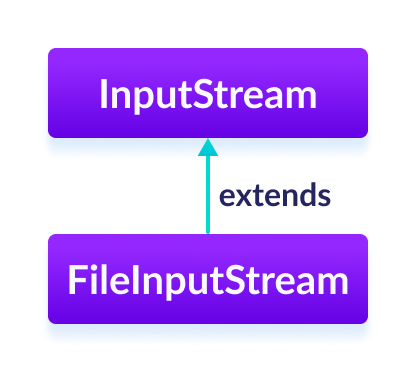The FileInputStream class of the java.io package can be used to read data (in bytes) from files.
It extends the InputStream abstract class.

Before we learn about FileInputStream, make sure to know about Java Files.
Create a FileInputStream
In order to create a file input stream, we must import the java.io.FileInputStream package first. Once we import the package, here is how we can create a file input stream in Java.
1. Using the path to file
FileInputStream input = new FileInputStream(stringPath);
Here, we have created an input stream that will be linked to the file specified by the path.
2. Using an object of the file
FileInputStream input = new FileInputStream(File fileObject);
Here, we have created an input stream that will be linked to the file specified by fileObject.
Methods of FileInputStream
The FileInputStream class provides implementations for different methods present in the InputStream class.
read() Method
read()- reads a single byte from the fileread(byte[] array)- reads the bytes from the file and stores in the specified arrayread(byte[] array, int start, int length)- reads the number of bytes equal to length from the file and stores in the specified array starting from the position start
Suppose we have a file named input.txt with the following content.
This is a line of text inside the file.
Let's try to read this file using FileInputStream.
import java.io.FileInputStream;
public class Main {
public static void main(String args[]) {
try {
FileInputStream input = new FileInputStream("input.txt");
System.out.println("Data in the file: ");
// Reads the first byte
int i = input.read();
while(i != -1) {
System.out.print((char)i);
// Reads next byte from the file
i = input.read();
}
input.close();
}
catch(Exception e) {
e.getStackTrace();
}
}
}
Output
Data in the file: This is a line of text inside the file.
In the above example, we have created a file input stream named input. The input stream is linked with the input.txt file.
FileInputStream input = new FileInputStream("input.txt");
To read data from the file, we have used the read() method inside the while loop.
available() Method
To get the number of available bytes, we can use the available() method. For example,
import java.io.FileInputStream;
public class Main {
public static void main(String args[]) {
try {
// Suppose, the input.txt file contains the following text
// This is a line of text inside the file.
FileInputStream input = new FileInputStream("input.txt");
// Returns the number of available bytes
System.out.println("Available bytes at the beginning: " + input.available());
// Reads 3 bytes from the file
input.read();
input.read();
input.read();
// Returns the number of available bytes
System.out.println("Available bytes at the end: " + input.available());
input.close();
}
catch (Exception e) {
e.getStackTrace();
}
}
}
Output
Available bytes at the beginning: 39 Available bytes at the end: 36
In the above example,
- We first use the
available()method to check the number of available bytes in the file input stream. - We then have used the
read()method 3 times to read 3 bytes from the file input stream. - Now, after reading the bytes we again have checked the available bytes. This time the available bytes decreased by 3.
skip() Method
To discard and skip the specified number of bytes, we can use the skip() method. For example,
import java.io.FileInputStream;
public class Main {
public static void main(String args[]) {
try {
// Suppose, the input.txt file contains the following text
// This is a line of text inside the file.
FileInputStream input = new FileInputStream("input.txt");
// Skips the 5 bytes
input.skip(5);
System.out.println("Input stream after skipping 5 bytes:");
// Reads the first byte
int i = input.read();
while (i != -1) {
System.out.print((char) i);
// Reads next byte from the file
i = input.read();
}
// close() method
input.close();
}
catch (Exception e) {
e.getStackTrace();
}
}
}
Output
Input Stream after skipping 5 bytes: is a line of text inside the file.
In the above example, we have used the skip() method to skip 5 bytes of data from the file input stream. Hence, the bytes representing the text "This " is not read from the input stream.
close() Method
To close the file input stream, we can use the close() method. Once the close() method is called, we cannot use the input stream to read data.
In all the above examples, we have used the close() method to close the file input stream.
Other Methods Of FileInputStream
| Methods | Descriptions |
|---|---|
finalize() |
ensures that the close() method is called |
getChannel() |
returns the object of FileChannel associated with the input stream |
getFD() |
returns the file descriptor associated with the input stream |
mark() |
mark the position in input stream up to which data has been read |
reset() |
returns the control to the point in the input stream where the mark was set |
To learn more, visit Java FileInputStream (official Java documentation).